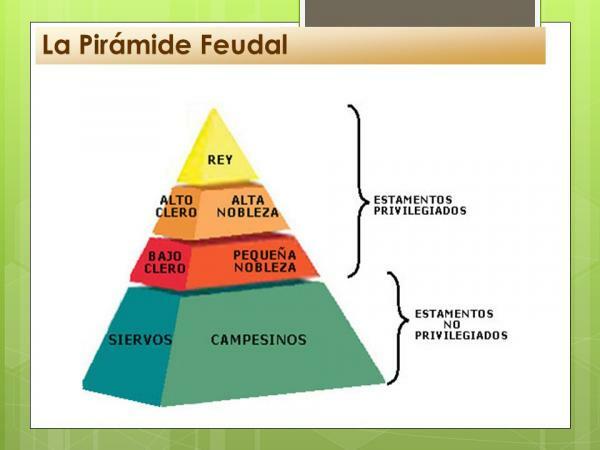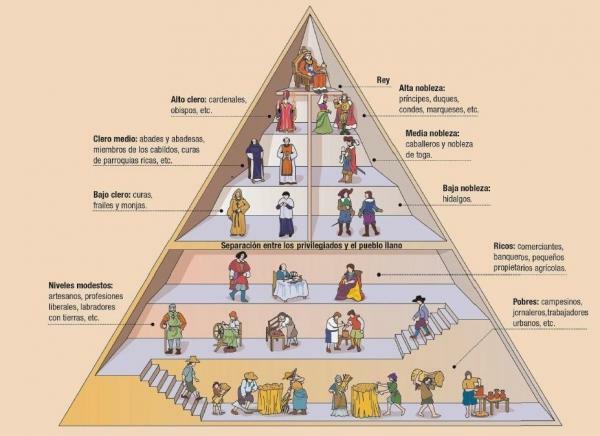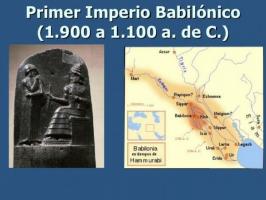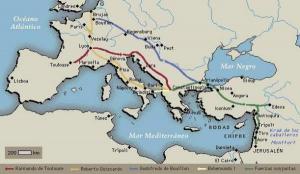Feudal society: main characteristics

Image: SlidePlayer
In this lesson from a TEACHER we are going to talk about social differences that existed during the Middle Ages, a period that ranges from S V-XV, so we will find a series of changes throughout this long time. So that you better understand what happened at the end of the Roman Empire as well as after its fall, in this lesson we are going to discover how society was divided so that you can understand the class division that took place at that time and that led to the appearance of feudalism. Keep reading and you will discover the main characteristics of feudal society.
Index
- What is feudalism: definition of the term
- Society in the Lower Roman Empire
- The main characteristics of feudal society
- Conclusion on feudalism
What is feudalism: definition of the term.
Before I start talking about the main characteristics of feudal society we must give a brief definition of what feudalism was. For this, we are going to briefly describe two of the meanings that we can find regarding this. First of all, the word
feudalism designates the set of institutions that supported the compromises given between free men, that is, between the vassal and the lord. The first received from the lord a fiefdom, which could be land or income, and the second received the auxilium, that is, the help that he needed at the time (which used to be of the military type).On the other hand we will find the definition made by Karl Marx in which he said that it was a mode of production with socioeconomic relationships, which placed people between the slavery of antiquity and modern capitalism. It is, then, the set of relations of production and dependency that were made between the peasant and the landowner, who gave them in usufruct to the peasant in exchange for a benefit.
In this video of a PROFESSOR we discover the Karl Marx thought.
Society in the Lower Roman Empire.
To understand the feudal society, we must place ourselves in the end of the Western Roman Empire or what is the same, in the Lower Empire, as it will be what happens at that time that marks the future of society (among other factors).
Society in the Lower Empire consisted of:
- Honorati: they represented 3% of the population and was made up of senators and landowners. This group had no tax burdens.
- Honestiore: it represented 17% of the population and was made up of the curia, the clergy, high officials, some soldiers, bankers, doctors,... This group when the republic falls, that is, the state, will disappear, since they were part of the bureaucratic apparatus.
- Humiliore: it represented 80% of the population and was made up of peasants and artisans. They lived in a difficult situation, because they were oppressed by taxes and by the muneraforced labor). From an edict, they were forced to work in the same capacity as their parents, so that the State could have all their needs covered. Still, it was a free status.
It is important to know these data in order to later understand feudal society, because it was here that the vassal system began to germinate (which we will explain later), since the honesty or the big landowners began to buy the lands of the humiliores to obtain more income in exchange for protecting them from the imperial officials who sought to collect taxes on said lands.
Thus the Roman Empire was losing, little by little, the income until falling into a great bankruptcy that prevented the payment and supplies of the imperial troops stationed at the limex for the defense of the border.

Image: Approach the Social
The main characteristics of feudal society.
After the fall of the Roman Empire, we will find ourselves before a divided Europe in the barbarian kingdoms, which were acculturated with the customs of Roman society. From the XI century we have a description of the social classes that existed at the time, they were written by a bishop called Adalberón de Laoin and in this text he explained that the three classes were very necessary and that if any of them failed, the system:
- Laboratores: those who work with their hands, that is, peasants and artisans.
- Bellatores: those who fight and defend the other classes.
- Oratores: those who pray to save the other two classes.
As we can see, it is a very basic summary of society, but it represents quite exactly what happened in the Middle Ages. Now, we can go on to look closely at each of these social classes that made up the Feudal Society:
Privileged group in feudal society
- Nobles: It will be a heterogeneous group because we will find great landowners who also had huge amounts of fortune and on the other hand we will find totally ruined people who could even live worse than any peasant of the time (most of these were in vassal dependence on the great Sirs). The only thing that united them was that they did not have to pay tribute to the Crown. Within this we will find the kings themselves.
- Clergy: It will also be a very large and heterogeneous group, since we will find from the great bishops to a simple parish priest of a district. Depending on this they would have one fortune or another. They were also exempt from paying taxes and also charged for administering the sacraments and received rents (they owned their own land).
Unprivileged group in feudalism
- Patriciado: from the Full Middle Ages (S X-XIII) began to appear what we will call as The bourgeoisie, a group of people who without being noble, began to obtain great fortunes thanks to trade. They were not recognized as nobles (although if they lived better than these in many cases) therefore they had to pay taxes. So his goal was to access the privileged group, through marriage contracts.
- Farmers: they could have small or medium lands or not, but over time they were selling them to the great lords to be able to stop paying the enormous taxes to which they were subjected, since the lords when obtaining the lands were obliged to defend their vassals (system vassal).
- Craftsmen: They had no recognition whatsoever and to defend themselves from the abuses of the authorities they joined in unions, which fixed the wages and prices at which the products had to be sold. They had to pay taxes and only a few would get rich enough to change their lives.
In this video of a PROFESSOR we discover the the fall of the Roman empire and the entry of the Visigoths into Spain.
Conclusion on feudalism.
Feudal society is merely a personal relationship with the strongest group, where a pyramid of power is created, in which the highest peak was the monarchy (since everything that was below it was under its domination).
Even so, there were times when the system was on the verge of breaking down, generating a series of rebellions such as those that we will find in France or in the Iberian Peninsula.
If you want to read more articles similar to Feudal society: main characteristics, we recommend that you enter our category of Story.



